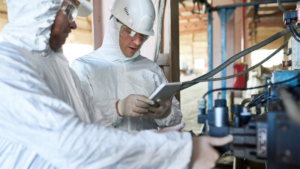Related Courses
Waste is considered hazardous if it, or any of its ingredients, pose a potential threat to human health or the environment. It can come in solid, liquid or gas form. The UK produces over 4 million tonnes of hazardous waste every year, so it’s vital it is treated and disposed of safely, with its harmful effects eliminated.
What Counts as Hazardous Waste?
Almost all businesses will produce hazardous waste. Items such as batteries, printer toners, laptop computers and paint cans can all be classified as hazardous and need to be disposed of with the greatest care. Organisations dealing with special kinds of chemical or medical waste also need to be sure they are disposing of it safely in a way that protects their workers, the public, animals and the environment.
The Environment Agency provides detailed guidance on classifying waste as hazardous or non-hazardous. Different types of waste have their own waste classification code (also known as a LoW (List of Waste) or EWC (European Waste Catalogue) code).
Providing contractors with this information forms part of an employer’s duty of care and helps to ensure the waste is treated appropriately.
Under the Control of Substances Hazardous to Health Regulations 2002 (COSHH), employers must carry out a risk assessment for any hazardous materials on-site. This ensures workers are kept safe and appropriately trained in how to deal with any hazardous substances they encounter at work.

How Should Hazardous Waste be Disposed of?
Once the hazardous waste is correctly classified, it becomes easier to think about which steps should be taken to handle it correctly. It’s illegal to mix hazardous and non-hazardous waste, or to mix different types of hazardous waste, so it must be stored carefully. If a used light bulb (some of which are classified as hazardous) is thrown into a dustbin containing otherwise non-hazardous waste, for example, the entire bin could be classified as hazardous and would need to be handled with special care.
Specialist waste management companies can transport hazardous materials away from your workplace safely. To do so, they will require an accurate waste classification code, along with:
– the substance’s name and the process that produced it
– any risks associated with the waste
– a chemical and physical analysis of it
With proper treatment to remove the hazardous elements, certain types of waste can be recycled, which reduces landfill and helps the environment.
The penalties for the incorrect handling of hazardous waste are severe, since the consequences can be very serious or even deadly. In 2017, Churngold Recycling Ltd were ordered to pay more than £30,000 in fines and costs after supplying toxic material to a building site in Avonmouth. They had removed over 30,000 tonnes of waste containing asbestos, heavy metals and hazardous chemicals (including cyanide) from a site, and were supposed to treat this waste and recycle it so that it was safe to use in the construction of a new Co-op distribution centre. Once delivered, the material was judged to be highly unsafe, causing health issues for workers at the new site. Some workers reported irritated eyes and issues caused by the smell of the materials. The company and its directors were prosecuted, and the business suffered heavy financial losses.
What Needs to be Done While the Hazardous Waste is in the Workplace?
Before the hazardous waste can be transported away, it might be necessary to store it for a short time. It should be kept away from ordinary waste and any fire safety concerns should be addressed in terms of where and how it’s stored; it might pose a fire risk if it’s left in direct sunlight, for example. It helps to check the requirements and laws regarding the type of hazardous waste in question. Collection by an authorised and registered waste carrier must take place as soon as possible.
Under COSHH, all employees must be trained in any hazardous substances they come into contact with. Their contact with it should be minimised as far as possible and they must be provided with any Personal Protective Equipment (PPE) they need.
Companies that don’t work with toxic chemicals or highly flammable substances regularly may not realise that hazardous waste is a subject they need to consider, but all businesses produce hazardous waste and all are subject to the requirements of COSHH. By working to ensure all hazardous waste is recognised, classified and disposed of correctly, employers can make sure that people and the environment are protected.



